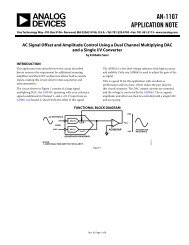Jennifer Zhao - EEWeb
Jennifer Zhao - EEWeb
Jennifer Zhao - EEWeb
Create successful ePaper yourself
Turn your PDF publications into a flip-book with our unique Google optimized e-Paper software.
PULSE<br />
With added complexity in embedded<br />
systems comes the need for more<br />
pins especially general purpose inputs<br />
and outputs that are more versatile. In<br />
late 2012, NXP Semiconductors—the<br />
inventors of the I 2 C-bus—launched a<br />
GPIO family of devices to remedy these<br />
limitations. The new family of peripheral<br />
expanders includes an innovative<br />
feature set called Agile I/O that helps<br />
integrate common system functions<br />
within the semiconductor. This new<br />
family allows the user to expand their<br />
interface without taking up much<br />
additional board space.<br />
8 Visit: eeweb.com<br />
Device Family Overview<br />
“These peripheral expanders are an expansion of our<br />
current GPIO family, which is the broadest portfolio<br />
in the market,” says <strong>Jennifer</strong> <strong>Zhao</strong>, General Manager<br />
of NXP’s System Management product line. NXP’s<br />
new line is able to expand the two wires of the I2C bus into 8-bit and 16-bit, inputs and outputs. These<br />
general-purpose I/O pins have consolidated interfacing<br />
functions that eliminate the amount of external<br />
components needed on the PCB, which saves space<br />
and simplifies the design.<br />
Addressing Industry Trends<br />
The Agile I/O expanders also have a reduced package<br />
size, which is another trend in the industry. “We have<br />
what we call HLA BGA, which is a really small 0.4 mm<br />
pitch package to address the trend of saving board<br />
space,” says <strong>Jennifer</strong> <strong>Zhao</strong>. Although the new packages<br />
are significantly smaller, there is no cost premium.<br />
Addressing the industry trend of lower voltages, the<br />
new GPIO family has very low voltage operation, from<br />
1.65 to 5.5 volts. In addition, it has a very low standby<br />
current with a maximum of 3mA. With an expansive<br />
FEATURED ARTICLE<br />
voltage range to choose from, NXP has allowed<br />
customers the option of selecting the optimal device<br />
for their applications. Some devices have two supply<br />
pins to allow separate voltage selections for the I2C-bus interface and the I/O interface.<br />
Visit: eeweb.com<br />
9















